Overview
- Brief Narrative
- Ration coupon used by Adolph Blau and his family when they were imprisoned in the Theresienstadt ghetto-labor camp. All currency was confiscated upon entry and replaced with scrip and ration coupons that could be exchanged only in the camp. Adolph, his wife, two children, and mother-in-law were deported from Vienna, Austria, in 1942. They lived in the camp until the International Red Cross took over administration of the camp from the Germans on May 2, 1945. The family then was transferred to the Deggendorf displaced persons camp in Germany where they lived until their immigration to the United States in 1948.
- Date
-
use:
1942-1945
- Geography
-
issue:
Theresienstadt (concentration camp);
Terezin (Ustecky kraj, Czech Republic)
- Credit Line
- United States Holocaust Memorial Museum Collection, Gift of Jeffrey A. Gordon
- Markings
- front, top right corner, surrounded by green ink : Ɑ
front, top right corner, printed in green and white : D (sideways)
front, top right corner, printed in green ink : (partial) ESSE / SORCFÄLTIC [EAT / ?]
front, left side, superimposed over 3 lines, stamped in black : P
front, center, printed in green ink and stamped in black : No 41679
front, right center, printed in green ink : VERPFLEGS-EINHEIT [ADDITIONAL FOOD UNIT]
front, center, printed in green ink, handwritten in blue ink, stamped in blue : BL / HS EVII / ZR. 76/ MDN. MARZ
front, bottom center, printed in green ink and handwritten in blue : Blau Adolf / TR IV/7 786 - Contributor
-
Subject:
Adolph Blau
- Biography
-
Adolph Blau was born in Vienna, Austria. During World War I (1914-1918), he served in the Austrian-Hungarian Army and was awarded the Iron Cross and the Silver Medal of Bravery. After the war, he received a license from the Austrian Government to sell tobacco, a trade reserved for veterans. In 1924, Adolph married Elsa Rosenthal at the Turkish Temple, a Sephardic synagogue. They were observant Jews and had two children, Gertrude, born March 14, 1925, and Herbert, born July 28, 1931.
On March 12, 1938, German troops marched into Austria and annexed the country. Anti-Jewish legislation was soon enacted to exclude Jews from Austrian society. The November 1938 Kristallnacht [Night of Broken Glass] pogrom was particularly brutal in Austria. Thousands of Jews were arrested and deported to concentration camps. Adolph's status as a decorated, disabled war veteran gave the family some preotection and, with the help of friends, he was able to maintain his tobacco trade a while longer. In August 1942, the family, which included his mother-in-law, Fanny Rosenthal, was deported to Theresienstadt concentration camp in Czechoslovakia, avoiding Auschwitz possibly because of his veteran's status. The family was separated, as men and women were housed in different barracks. Elsa served as forced labor in a Messerschmitt airplane factory. Some elements of family life were maintained, as Herbert was Bar Mitzahed by Rabbi Leo Baeck in 1944. Soon afterwards, however, Gertrude was deported to Auschwitz.
On May 2, 1945, the Germans transferred administration of the camp to the International Red Cross. Gertrude had located and rejoined them around this time. The family was sent to Deggendorf displaced persons camp in Germany, where Adolph served on the Jewish Committee and as a director of the ORT (Organization for Rehabilitation through Training) vocational school. In November 1947, with the assistance of the Hebrew Immigrant Aid Society, Adolph and his family were permitted to immigrate to the United States. They eventually settled in Vineland, New Jersey, where Adolph died in 1958.
Physical Details
- Language
- German
- Classification
-
Exchange Media
- Category
-
Coupons
- Object Type
-
Ration cards (lcsh)
- Physical Description
- Irregularly cut, rectangular, yellowed light brown paper coupon. The front has preprinted graphics with German text in green ink with green shading. There are entry boxes and lines that are filled in by hand in blue ink. On the right side is a stamped image of 2 tunnels in dark blue ink; below this is a month stamp; on the left side is a oversized P stamp. Coupons have been clipped off the lower and upper sections. A partial circular seal is stamped in blue ink on the reverse; it is partially printoed upon a paper stamp adhered on the right.
- Dimensions
- overall: Height: 2.750 inches (6.985 cm) | Width: 4.000 inches (10.16 cm)
- Materials
- overall : paper, ink, adhesive
Rights & Restrictions
- Conditions on Access
- No restrictions on access
- Conditions on Use
- No restrictions on use
Keywords & Subjects
- Topical Term
- Concentration camp inmates--Czech Republic--Terezín (Ustecky kraj) Holocaust, Jewish (1939-1945)--Austria--Vienna--Personal narratives. Jewish families--Austria--Vienna. Jewish refugees--Germany--Deggendorf. World War, 1939-1945--Deportations from Austria. World War, 1939-1945--Refugees--Germany--Deggendorf.
Administrative Notes
- Legal Status
- Permanent Collection
- Provenance
- The ration coupon was donated to the United States Holocaust Memorial Museum in 2005 by Jeffrey A. Gordon, the son of Gertrude Blau Gordon.
- Record last modified:
- 2023-09-19 12:01:52
- This page:
- https://collections.ushmm.org/search/catalog/irn517884
Download & Licensing
In-Person Research
- By Appointment
- Request 21 Days in Advance of Visit
- Plan a Research Visit
- Request to See This Object
Contact Us
Also in Adolph Blau family collection
The collection consists of artifacts and documents relating to the experiences of Adolph Blau and his family in Theresienstadt concentration camp during the Holocaust and in Deggendorf displaced persons camp in the postwar period.
Date: 1937-1948
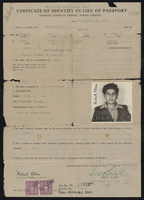
Blau family papers
Document
The Blau family papers consist of certificates, identification papers, immigration documents, school report cards, and a poetry and autograph book documenting the Blau family from Vienna, Austria, their imprisonment in Theresienstadt, their postwar lives at the Deggendorf displaced persons camp, and their immigration to the United States in 1947. The poetry and autograph book likely belonged to Gertrude and contains entries from friends in Vienna and Theresienstadt, including many references to Palestine. School report cards document Herbert’s education in Vienna and Deggendorf. Identification papers include prewar Austrian passports, wartime German passports, and a postwar repatriation card. Theresienstadt materials include a work pass, milk card, and bankbook. Deggendorf records include identification papers and certificates. Immigration documents include immigration forms and naturalization papers.
![Kriegserinnerungsmedaille [War Commemorative Medal], 1914-1918 awarded to a Jewish soldier Kriegserinnerungsmedaille [War Commemorative Medal], 1914-1918 awarded to a Jewish soldier](https://www.ushmm.org/media/emu/get?irn=523255&mm_irn=18325&file=secondary)
Kriegserinnerungsmedaille [War Commemorative Medal], 1914-1918 awarded to a Jewish soldier
Object
Commemorative medal awarded to Adolph Blau for his service in the Austro-Hungarian Army during World War I. It was designed by by the Austrian sculptor, Edwin Grienauer. Adolph, his wife, two children, and his mother-in-law were deported by the Germans from Vienna, Austria, to Theresienstadt in 1942. His daughter, Trudy, was deported to Auschwitz in 1944. Trudy rejoined the family in the spring of 1945. They lived in Terezin until the International Red Cross took over administration of the camp from the Germans on May 2, 1945. The family then was transferred to Deggendorf displaced persons camp in Germany where they lived until their emigration to the United States in 1948.

Torah mantle with embroidered crown used for Bar Mitzvah at Theresienstadt
Object
Torah mantle used for the Bar Mitzvah of thirteen year old Herbert Blau in July 1944 in the Theresienstadt ghetto in Czechoslovakia. The service was presided over by Rabbi Leo Baeck. Herbert's youth group gave him his own tin of sardines to celebrate the event. Herbert and his family were deported by the Germans from Vienna, Austria, in 1942. They lived in Terezin until the International Red Cross took over administration of the camp from the Germans on May 2, 1945. The family then was transferred to the Deggendorf displaced persons camp in Germany where they lived until their emigration to the United States in 1948.
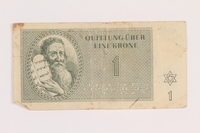
Theresienstadt ghetto-labor camp scrip, 1 krone note
Object
Scrip used by Adolph Blau and his family when they were imprisoned in the Theresienstadt ghetto-labor camp. All currency was confiscated upon entry and replaced with scrip and ration coupons that could be exchanged only in the camp. Adolph, his wife, two children, and mother-in-law were deported from Vienna, Austria, in 1942. They lived in the camp until the International Red Cross took over administration of the camp from the Germans on May 2, 1945. The family then was transferred to the Deggendorf displaced persons camp in Germany where they lived until their immigration to the United States in 1948.
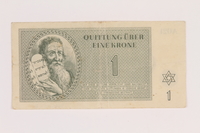
Theresienstadt ghetto-labor camp scrip, 1 krone note
Object
Scrip used by Adolph Blau and his family when they were imprisoned in the Theresienstadt ghetto-labor camp. All currency was confiscated upon entry and replaced with scrip and ration coupons that could be exchanged only in the camp. Adolph, his wife, two children, and mother-in-law were deported from Vienna, Austria, in 1942. They lived in the camp until the International Red Cross took over administration of the camp from the Germans on May 2, 1945. The family then was transferred to the Deggendorf displaced persons camp in Germany where they lived until their immigration to the United States in 1948.
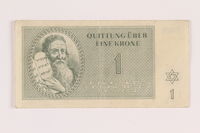
Theresienstadt ghetto-labor camp scrip, 1 krone note
Object
Scrip used by Adolph Blau and his family when they were imprisoned in the Theresienstadt ghetto-labor camp. All currency was confiscated upon entry and replaced with scrip and ration coupons that could be exchanged only in the camp. Adolph, his wife, two children, and mother-in-law were deported from Vienna, Austria, in 1942. They lived in the camp until the International Red Cross took over administration of the camp from the Germans on May 2, 1945. The family then was transferred to the Deggendorf displaced persons camp in Germany where they lived until their immigration to the United States in 1948.

Theresienstadt ghetto-labor camp scrip, 1 krone note
Object
Scrip used by Adolph Blau and his family when they were imprisoned in the Theresienstadt ghetto-labor camp. All currency was confiscated upon entry and replaced with scrip and ration coupons that could be exchanged only in the camp. Adolph, his wife, two children, and mother-in-law were deported from Vienna, Austria, in 1942. They lived in the camp until the International Red Cross took over administration of the camp from the Germans on May 2, 1945. The family then was transferred to the Deggendorf displaced persons camp in Germany where they lived until their immigration to the United States in 1948.

Theresienstadt ghetto-labor camp scrip, 1 krone note
Object
Scrip used by Adolph Blau and his family when they were imprisoned in the Theresienstadt ghetto-labor camp. All currency was confiscated upon entry and replaced with scrip and ration coupons that could be exchanged only in the camp. Adolph, his wife, two children, and mother-in-law were deported from Vienna, Austria, in 1942. They lived in the camp until the International Red Cross took over administration of the camp from the Germans on May 2, 1945. The family then was transferred to the Deggendorf displaced persons camp in Germany where they lived until their immigration to the United States in 1948.
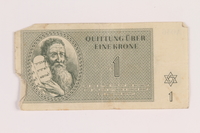
Theresienstadt ghetto-labor camp scrip, 1 krone note
Object
Scrip used by Adolph Blau and his family when they were imprisoned in the Theresienstadt ghetto-labor camp. All currency was confiscated upon entry and replaced with scrip and ration coupons that could be exchanged only in the camp. Adolph, his wife, two children, and mother-in-law were deported from Vienna, Austria, in 1942. They lived in the camp until the International Red Cross took over administration of the camp from the Germans on May 2, 1945. The family then was transferred to the Deggendorf displaced persons camp in Germany where they lived until their immigration to the United States in 1948.
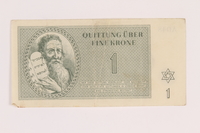
Theresienstadt ghetto-labor camp scrip, 1 krone note
Object
Scrip used by Adolph Blau and his family when they were imprisoned in the Theresienstadt ghetto-labor camp. All currency was confiscated upon entry and replaced with scrip and ration coupons that could be exchanged only in the camp. Adolph, his wife, two children, and mother-in-law were deported from Vienna, Austria, in 1942. They lived in the camp until the International Red Cross took over administration of the camp from the Germans on May 2, 1945. The family then was transferred to the Deggendorf displaced persons camp in Germany where they lived until their immigration to the United States in 1948.
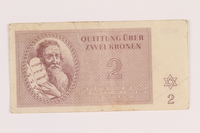
Theresienstadt ghetto-labor camp scrip, 2 kronen note
Object
Scrip used by Adolph Blau and his family when they were imprisoned in the Theresienstadt ghetto-labor camp. All currency was confiscated upon entry and replaced with scrip and ration coupons that could be exchanged only in the camp. Adolph, his wife, two children, and mother-in-law were deported from Vienna, Austria, in 1942. They lived in the camp until the International Red Cross took over administration of the camp from the Germans on May 2, 1945. The family then was transferred to the Deggendorf displaced persons camp in Germany where they lived until their immigration to the United States in 1948.
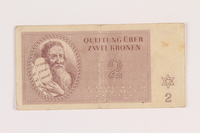
Theresienstadt ghetto-labor camp scrip, 2 kronen note
Object
Scrip used by Adolph Blau and his family when they were imprisoned in the Theresienstadt ghetto-labor camp. All currency was confiscated upon entry and replaced with scrip and ration coupons that could be exchanged only in the camp. Adolph, his wife, two children, and mother-in-law were deported from Vienna, Austria, in 1942. They lived in the camp until the International Red Cross took over administration of the camp from the Germans on May 2, 1945. The family then was transferred to the Deggendorf displaced persons camp in Germany where they lived until their immigration to the United States in 1948.
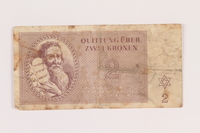
Theresienstadt ghetto-labor camp scrip, 2 kronen note
Object
Scrip used by Adolph Blau and his family when they were imprisoned in the Theresienstadt ghetto-labor camp. All currency was confiscated upon entry and replaced with scrip and ration coupons that could be exchanged only in the camp. Adolph, his wife, two children, and mother-in-law were deported from Vienna, Austria, in 1942. They lived in the camp until the International Red Cross took over administration of the camp from the Germans on May 2, 1945. The family then was transferred to the Deggendorf displaced persons camp in Germany where they lived until their immigration to the United States in 1948.
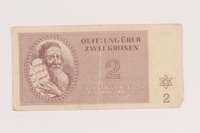
Theresienstadt ghetto-labor camp scrip, 2 kronen note
Object
Scrip used by Adolph Blau and his family when they were imprisoned in the Theresienstadt ghetto-labor camp. All currency was confiscated upon entry and replaced with scrip and ration coupons that could be exchanged only in the camp. Adolph, his wife, two children, and mother-in-law were deported from Vienna, Austria, in 1942. They lived in the camp until the International Red Cross took over administration of the camp from the Germans on May 2, 1945. The family then was transferred to the Deggendorf displaced persons camp in Germany where they lived until their immigration to the United States in 1948.
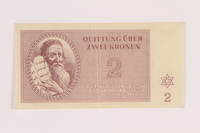
Theresienstadt ghetto-labor camp scrip, 2 kronen note
Object
Scrip used by Adolph Blau and his family when they were imprisoned in the Theresienstadt ghetto-labor camp. All currency was confiscated upon entry and replaced with scrip and ration coupons that could be exchanged only in the camp. Adolph, his wife, two children, and mother-in-law were deported from Vienna, Austria, in 1942. They lived in the camp until the International Red Cross took over administration of the camp from the Germans on May 2, 1945. The family then was transferred to the Deggendorf displaced persons camp in Germany where they lived until their immigration to the United States in 1948.
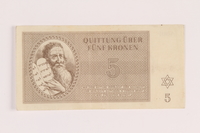
Theresienstadt ghetto-labor camp scrip, 5 kronen note
Object
Scrip used by Adolph Blau and his family when they were imprisoned in the Theresienstadt ghetto-labor camp. All currency was confiscated upon entry and replaced with scrip and ration coupons that could be exchanged only in the camp. Adolph, his wife, two children, and mother-in-law were deported from Vienna, Austria, in 1942. They lived in the camp until the International Red Cross took over administration of the camp from the Germans on May 2, 1945. The family then was transferred to the Deggendorf displaced persons camp in Germany where they lived until their immigration to the United States in 1948.

Theresienstadt ghetto-labor camp scrip, 5 kronen note
Object
Scrip used by Adolph Blau and his family when they were imprisoned in the Theresienstadt ghetto-labor camp. All currency was confiscated upon entry and replaced with scrip and ration coupons that could be exchanged only in the camp. Adolph, his wife, two children, and mother-in-law were deported from Vienna, Austria, in 1942. They lived in the camp until the International Red Cross took over administration of the camp from the Germans on May 2, 1945. The family then was transferred to the Deggendorf displaced persons camp in Germany where they lived until their immigration to the United States in 1948.
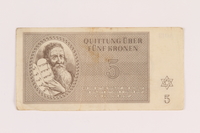
Theresienstadt ghetto-labor camp scrip, 5 kronen note
Object
Scrip used by Adolph Blau and his family when they were imprisoned in the Theresienstadt ghetto-labor camp. All currency was confiscated upon entry and replaced with scrip and ration coupons that could be exchanged only in the camp. Adolph, his wife, two children, and mother-in-law were deported from Vienna, Austria, in 1942. They lived in the camp until the International Red Cross took over administration of the camp from the Germans on May 2, 1945. The family then was transferred to the Deggendorf displaced persons camp in Germany where they lived until their immigration to the United States in 1948.
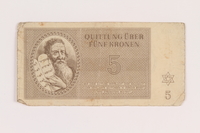
Theresienstadt ghetto-labor camp scrip, 5 kronen note
Object
Scrip used by Adolph Blau and his family when they were imprisoned in the Theresienstadt ghetto-labor camp. All currency was confiscated upon entry and replaced with scrip and ration coupons that could be exchanged only in the camp. Adolph, his wife, two children, and mother-in-law were deported from Vienna, Austria, in 1942. They lived in the camp until the International Red Cross took over administration of the camp from the Germans on May 2, 1945. The family then was transferred to the Deggendorf displaced persons camp in Germany where they lived until their immigration to the United States in 1948.
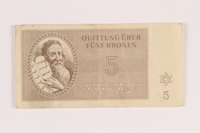
Theresienstadt ghetto-labor camp scrip, 5 kronen note
Object
Scrip used by Adolph Blau and his family when they were imprisoned in the Theresienstadt ghetto-labor camp. All currency was confiscated upon entry and replaced with scrip and ration coupons that could be exchanged only in the camp. Adolph, his wife, two children, and mother-in-law were deported from Vienna, Austria, in 1942. They lived in the camp until the International Red Cross took over administration of the camp from the Germans on May 2, 1945. The family then was transferred to the Deggendorf displaced persons camp in Germany where they lived until their immigration to the United States in 1948.

Theresienstadt ghetto-labor camp scrip, 5 kronen note
Object
Scrip used by Adolph Blau and his family when they were imprisoned in the Theresienstadt ghetto-labor camp. All currency was confiscated upon entry and replaced with scrip and ration coupons that could be exchanged only in the camp. Adolph, his wife, two children, and mother-in-law were deported from Vienna, Austria, in 1942. They lived in the camp until the International Red Cross took over administration of the camp from the Germans on May 2, 1945. The family then was transferred to the Deggendorf displaced persons camp in Germany where they lived until their immigration to the United States in 1948.
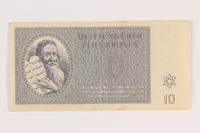
Theresienstadt ghetto-labor camp scrip, 10 kronen note
Object
Scrip used by Adolph Blau and his family when they were imprisoned in the Theresienstadt ghetto-labor camp. All currency was confiscated upon entry and replaced with scrip and ration coupons that could be exchanged only in the camp. Adolph, his wife, two children, and mother-in-law were deported from Vienna, Austria, in 1942. They lived in the camp until the International Red Cross took over administration of the camp from the Germans on May 2, 1945. The family then was transferred to the Deggendorf displaced persons camp in Germany where they lived until their immigration to the United States in 1948.

Theresienstadt ghetto-labor camp scrip, 10 kronen note
Object
Scrip used by Adolph Blau and his family when they were imprisoned in the Theresienstadt ghetto-labor camp. All currency was confiscated upon entry and replaced with scrip and ration coupons that could be exchanged only in the camp. Adolph, his wife, two children, and mother-in-law were deported from Vienna, Austria, in 1942. They lived in the camp until the International Red Cross took over administration of the camp from the Germans on May 2, 1945. The family then was transferred to the Deggendorf displaced persons camp in Germany where they lived until their immigration to the United States in 1948.

Theresienstadt ghetto-labor camp scrip, 10 kronen note
Object
Scrip used by Adolph Blau and his family when they were imprisoned in the Theresienstadt ghetto-labor camp. All currency was confiscated upon entry and replaced with scrip and ration coupons that could be exchanged only in the camp. Adolph, his wife, two children, and mother-in-law were deported from Vienna, Austria, in 1942. They lived in the camp until the International Red Cross took over administration of the camp from the Germans on May 2, 1945. The family then was transferred to the Deggendorf displaced persons camp in Germany where they lived until their immigration to the United States in 1948.
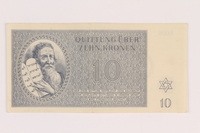
Theresienstadt ghetto-labor camp scrip, 10 kronen note
Object
Scrip used by Adolph Blau and his family when they were imprisoned in the Theresienstadt ghetto-labor camp. All currency was confiscated upon entry and replaced with scrip and ration coupons that could be exchanged only in the camp. Adolph, his wife, two children, and mother-in-law were deported from Vienna, Austria, in 1942. They lived in the camp until the International Red Cross took over administration of the camp from the Germans on May 2, 1945. The family then was transferred to the Deggendorf displaced persons camp in Germany where they lived until their immigration to the United States in 1948.
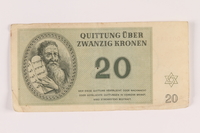
Theresienstadt ghetto-labor camp scrip, 20 kronen note
Object
Scrip used by Adolph Blau and his family when they were imprisoned in the Theresienstadt ghetto-labor camp. All currency was confiscated upon entry and replaced with scrip and ration coupons that could be exchanged only in the camp. Adolph, his wife, two children, and mother-in-law were deported from Vienna, Austria, in 1942. They lived in the camp until the International Red Cross took over administration of the camp from the Germans on May 2, 1945. The family then was transferred to the Deggendorf displaced persons camp in Germany where they lived until their immigration to the United States in 1948.

Theresienstadt ghetto-labor camp scrip, 20 kronen note
Object
Scrip used by Adolph Blau and his family when they were imprisoned in the Theresienstadt ghetto-labor camp. All currency was confiscated upon entry and replaced with scrip and ration coupons that could be exchanged only in the camp. Adolph, his wife, two children, and mother-in-law were deported from Vienna, Austria, in 1942. They lived in the camp until the International Red Cross took over administration of the camp from the Germans on May 2, 1945. The family then was transferred to the Deggendorf displaced persons camp in Germany where they lived until their immigration to the United States in 1948.

Theresienstadt ghetto-labor camp scrip, 20 kronen note
Object
Scrip used by Adolph Blau and his family when they were imprisoned in the Theresienstadt ghetto-labor camp. All currency was confiscated upon entry and replaced with scrip and ration coupons that could be exchanged only in the camp. Adolph, his wife, two children, and mother-in-law were deported from Vienna, Austria, in 1942. They lived in the camp until the International Red Cross took over administration of the camp from the Germans on May 2, 1945. The family then was transferred to the Deggendorf displaced persons camp in Germany where they lived until their immigration to the United States in 1948.
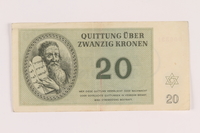
Theresienstadt ghetto-labor camp scrip, 20 kronen note
Object
Scrip used by Adolph Blau and his family when they were imprisoned in the Theresienstadt ghetto-labor camp. All currency was confiscated upon entry and replaced with scrip and ration coupons that could be exchanged only in the camp. Adolph, his wife, two children, and mother-in-law were deported from Vienna, Austria, in 1942. They lived in the camp until the International Red Cross took over administration of the camp from the Germans on May 2, 1945. The family then was transferred to the Deggendorf displaced persons camp in Germany where they lived until their immigration to the United States in 1948.
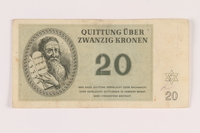
Theresienstadt ghetto-labor camp scrip, 20 kronen note
Object
Scrip used by Adolph Blau and his family when they were imprisoned in the Theresienstadt ghetto-labor camp. All currency was confiscated upon entry and replaced with scrip and ration coupons that could be exchanged only in the camp. Adolph, his wife, two children, and mother-in-law were deported from Vienna, Austria, in 1942. They lived in the camp until the International Red Cross took over administration of the camp from the Germans on May 2, 1945. The family then was transferred to the Deggendorf displaced persons camp in Germany where they lived until their immigration to the United States in 1948.
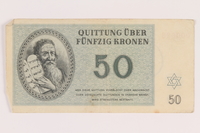
Theresienstadt ghetto-labor camp scrip, 50 kronen note
Object
Scrip used by Adolph Blau and his family when they were imprisoned in the Theresienstadt ghetto-labor camp. All currency was confiscated upon entry and replaced with scrip and ration coupons that could be exchanged only in the camp. Adolph, his wife, two children, and mother-in-law were deported from Vienna, Austria, in 1942. They lived in the camp until the International Red Cross took over administration of the camp from the Germans on May 2, 1945. The family then was transferred to the Deggendorf displaced persons camp in Germany where they lived until their immigration to the United States in 1948.

Theresienstadt ghetto-labor camp scrip, 50 kronen note
Object
Scrip used by Adolph Blau and his family when they were imprisoned in the Theresienstadt ghetto-labor camp. All currency was confiscated upon entry and replaced with scrip and ration coupons that could be exchanged only in the camp. Adolph, his wife, two children, and mother-in-law were deported from Vienna, Austria, in 1942. They lived in the camp until the International Red Cross took over administration of the camp from the Germans on May 2, 1945. The family then was transferred to the Deggendorf displaced persons camp in Germany where they lived until their immigration to the United States in 1948.
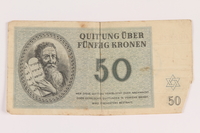
Theresienstadt ghetto-labor camp scrip, 50 kronen note
Object
Scrip used by Adolph Blau and his family when they were imprisoned in the Theresienstadt ghetto-labor camp. All currency was confiscated upon entry and replaced with scrip and ration coupons that could be exchanged only in the camp. Adolph, his wife, two children, and mother-in-law were deported from Vienna, Austria, in 1942. They lived in the camp until the International Red Cross took over administration of the camp from the Germans on May 2, 1945. The family then was transferred to the Deggendorf displaced persons camp in Germany where they lived until their immigration to the United States in 1948.
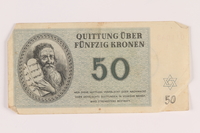
Theresienstadt ghetto-labor camp scrip, 50 kronen note
Object
Scrip used by Adolph Blau and his family when they were imprisoned in the Theresienstadt ghetto-labor camp. All currency was confiscated upon entry and replaced with scrip and ration coupons that could be exchanged only in the camp. Adolph, his wife, two children, and mother-in-law were deported from Vienna, Austria, in 1942. They lived in the camp until the International Red Cross took over administration of the camp from the Germans on May 2, 1945. The family then was transferred to the Deggendorf displaced persons camp in Germany where they lived until their immigration to the United States in 1948.
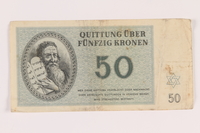
Theresienstadt ghetto-labor camp scrip, 50 kronen note
Object
Scrip used by Adolph Blau and his family when they were imprisoned in the Theresienstadt ghetto-labor camp. All currency was confiscated upon entry and replaced with scrip and ration coupons that could be exchanged only in the camp. Adolph, his wife, two children, and mother-in-law were deported from Vienna, Austria, in 1942. They lived in the camp until the International Red Cross took over administration of the camp from the Germans on May 2, 1945. The family then was transferred to the Deggendorf displaced persons camp in Germany where they lived until their immigration to the United States in 1948.
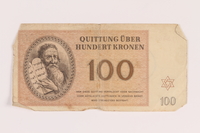
Theresienstadt ghetto-labor camp scrip, 100 kronen note
Object
Scrip used by Adolph Blau and his family when they were imprisoned in the Theresienstadt ghetto-labor camp. All currency was confiscated upon entry and replaced with scrip and ration coupons that could be exchanged only in the camp. Adolph, his wife, two children, and mother-in-law were deported from Vienna, Austria, in 1942. They lived in the camp until the International Red Cross took over administration of the camp from the Germans on May 2, 1945. The family then was transferred to the Deggendorf displaced persons camp in Germany where they lived until their immigration to the United States in 1948.
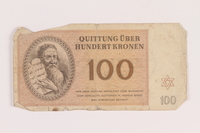
Theresienstadt ghetto-labor camp scrip, 100 kronen note
Object
Scrip used by Adolph Blau and his family when they were imprisoned in the Theresienstadt ghetto-labor camp. All currency was confiscated upon entry and replaced with scrip and ration coupons that could be exchanged only in the camp. Adolph, his wife, two children, and mother-in-law were deported from Vienna, Austria, in 1942. They lived in the camp until the International Red Cross took over administration of the camp from the Germans on May 2, 1945. The family then was transferred to the Deggendorf displaced persons camp in Germany where they lived until their immigration to the United States in 1948.

Theresienstadt ghetto-labor camp scrip, 100 kronen note
Object
Scrip used by Adolph Blau and his family when they were imprisoned in the Theresienstadt ghetto-labor camp. All currency was confiscated upon entry and replaced with scrip and ration coupons that could be exchanged only in the camp. Adolph, his wife, two children, and mother-in-law were deported from Vienna, Austria, in 1942. They lived in the camp until the International Red Cross took over administration of the camp from the Germans on May 2, 1945. The family then was transferred to the Deggendorf displaced persons camp in Germany where they lived until their immigration to the United States in 1948.
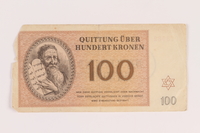
Theresienstadt ghetto-labor camp scrip, 100 kronen note
Object
Scrip used by Adolph Blau and his family when they were imprisoned in the Theresienstadt ghetto-labor camp. All currency was confiscated upon entry and replaced with scrip and ration coupons that could be exchanged only in the camp. Adolph, his wife, two children, and mother-in-law were deported from Vienna, Austria, in 1942. They lived in the camp until the International Red Cross took over administration of the camp from the Germans on May 2, 1945. The family then was transferred to the Deggendorf displaced persons camp in Germany where they lived until their immigration to the United States in 1948.
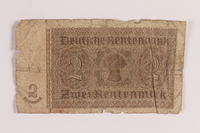
Weimar Germany, 2 Rentenmark note saved by an Austrian Jewish refugee
Object
Two rentenmark note issued as emergency currency in 1923 during the Weimar Republic to help control runaway inflation. It was saved by Adolph Blau and his family. Adolph, his wife, two children, and mother-in-law were deported by the Germans from Vienna, Austria, to the Theresienstadt ghetto-labor camp in Czechoslovakia in 1942. They lived in Terezin until the International Red Cross took over administration of the camp from the Germans on May 2, 1945. The family then was transferred to the Deggendorf displaced persons camp in the American zone in Germany where they lived until their immigration to the United States in 1948.
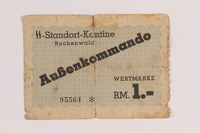
Buchenwald Aussenkommando slave labor subcamp, scrip, 1 mark note
Object
Buchenwald aussenkommando (outside unit) coupon with no overprint identifying the outside camp within the Buchenwald concentration camp system. Scrip was sometimes issued to forced laborers working in factories. Trudy (Gertrude) Blau may have been issued the scrip when she was imprisoned in Auschwitz and its various labor subcamps from 1944-1945. In 1942, Trudy and her family were deported by the Germans from Vienna, Austria, to the Theresienstadt ghetto-labor camp in Czechoslovakia. In 1944, Trudy volunteered to go to Auschwitz with some friends, and from there was sent to Kurzbach labor camp, where she worked digging ditches until she became ill with typhoid fever. In January 1945, the Germans decided to evacuate the camp because of advancing Soviet forces. While on a forced march, Trudy was liberated in Liegnitz, Germany, by the Soviets. She was reunited with her family in Theresienstadt in the spring of 1945. The family was transferred to the Deggendorf displaced persons camp in Germany where they lived until their emigration to the United States in 1948.
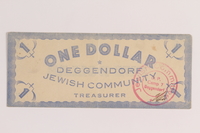
Deggendorf displaced persons camp scrip, 1 Dollar, issued to an Austrian Jewish family
Object
Jewish Community scrip for one Deggendorf dollar issued to Adolph Blau and his family in the Deggendorf displaced persons camp in Germany from 1945-1948. Adolph, his wife, two children, and mother-in-law had been deported in 1942 by the Germans from Vienna, Austria, to Theresienstadt ghetto-labor camp. They lived in the Terezin until the International Red Cross took over administration of the camp from the Germans on May 2, 1945. The family then was transferred to the Deggendorf displaced persons camp in the Bamberg district of Germany in the American zone. They lived there until their immigration to the United States in 1948.
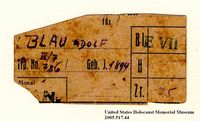
Theresienstadt ghetto-labor camp ration coupon used by an Austrian Jewish inmate
Object
Ration coupon used by Adolph Blau and his family when they were imprisoned in the Theresienstadt ghetto-labor camp. All currency was confiscated upon entry and replaced with scrip and ration coupons that could be exchanged only in the camp. Adolph, his wife, two children, and mother-in-law were deported from Vienna, Austria, in 1942. They lived in the camp until the International Red Cross took over administration of the camp from the Germans on May 2, 1945. The family then was transferred to the Deggendorf displaced persons camp in Germany where they lived until their immigration to the United States in 1948.
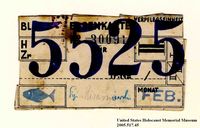
Theresienstadt ghetto-labor camp food ration coupon used by an Austrian Jewish inmate
Object
Ration coupon used by Adolph Blau and his family when they were imprisoned in the Theresienstadt ghetto-labor camp. All currency was confiscated upon entry and replaced with scrip and ration coupons that could be exchanged only in the camp. Adolph, his wife, two children, and mother-in-law were deported from Vienna, Austria, in 1942. They lived in the camp until the International Red Cross took over administration of the camp from the Germans on May 2, 1945. The family then was transferred to the Deggendorf displaced persons camp in Germany where they lived until their immigration to the United States in 1948.
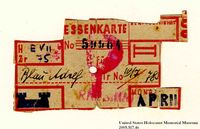
Theresienstadt ghetto-labor camp food ration coupon used by an Austrian Jewish prisoner
Object
Ration coupon used by Adolph Blau and his family when they were imprisoned in the Theresienstadt ghetto-labor camp. All currency was confiscated upon entry and replaced with scrip and ration coupons that could be exchanged only in the camp. Adolph, his wife, two children, and mother-in-law were deported from Vienna, Austria, in 1942. They lived in the camp until the International Red Cross took over administration of the camp from the Germans on May 2, 1945. The family then was transferred to the Deggendorf displaced persons camp in Germany where they lived until their immigration to the United States in 1948.
![Two Theresienstadt ghetto-labor camp Kaffeehaus [Coffee house] coupons issued to an Austrian Jewish prisoner Two Theresienstadt ghetto-labor camp Kaffeehaus [Coffee house] coupons issued to an Austrian Jewish prisoner](https://www.ushmm.org/media/emu/get?irn=517871&mm_irn=501344&file=secondary)
Two Theresienstadt ghetto-labor camp Kaffeehaus [Coffee house] coupons issued to an Austrian Jewish prisoner
Object
Two ration coupons issued to Adolph Blau and his family when they were imprisoned in the Theresienstadt ghetto-labor camp. These perforated coupons were still attached together at the end of the war and would originally have been part of a larger sheet of coupons. All currency was confiscated upon entry and replaced with scrip and ration coupons that could be exchanged only in the camp. Adolph, his wife, two children, and mother-in-law were deported from Vienna, Austria, in 1942. They lived in the camp until the International Red Cross took over administration of the camp from the Germans on May 2, 1945. The family then was transferred to the Deggendorf displaced persons camp in Germany where they lived until their immigration to the United States in 1948.
![Theresienstadt ghetto-labor camp Kaffeehaus [Coffee house] coupon issued to an Austrian Jewish prisoner Theresienstadt ghetto-labor camp Kaffeehaus [Coffee house] coupon issued to an Austrian Jewish prisoner](https://www.ushmm.org/media/emu/get?irn=517872&mm_irn=501345&file=secondary)
Theresienstadt ghetto-labor camp Kaffeehaus [Coffee house] coupon issued to an Austrian Jewish prisoner
Object
Ration coupon used by Adolph Blau and his family when they were imprisoned in the Theresienstadt ghetto-labor camp. All currency was confiscated upon entry and replaced with scrip and ration coupons that could be exchanged only in the camp. Adolph, his wife, two children, and mother-in-law were deported from Vienna, Austria, in 1942. They lived in the camp until the International Red Cross took over administration of the camp from the Germans on May 2, 1945. The family then was transferred to the Deggendorf displaced persons camp in Germany where they lived until their immigration to the United States in 1948.
![Theresienstadt ghetto-labor camp Kaffeehaus [Coffee house] coupon issued to an Austrian Jewish inmate Theresienstadt ghetto-labor camp Kaffeehaus [Coffee house] coupon issued to an Austrian Jewish inmate](https://www.ushmm.org/media/emu/get?irn=517873&mm_irn=501346&file=secondary)
Theresienstadt ghetto-labor camp Kaffeehaus [Coffee house] coupon issued to an Austrian Jewish inmate
Object
Ration coupon used by Adolph Blau and his family when they were imprisoned in the Theresienstadt ghetto-labor camp. All currency was confiscated upon entry and replaced with scrip and ration coupons that could be exchanged only in the camp. Adolph, his wife, two children, and mother-in-law were deported from Vienna, Austria, in 1942. They lived in the camp until the International Red Cross took over administration of the camp from the Germans on May 2, 1945. The family then was transferred to the Deggendorf displaced persons camp in Germany where they lived until their immigration to the United States in 1948.
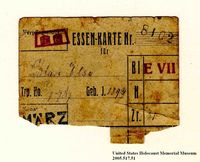
Theresienstadt ghetto-labor camp food coupon issued to an Austrian Jewish prisoner
Object
Ration coupon used by Adolph Blau and his family when they were imprisoned in the Theresienstadt ghetto-labor camp. All currency was confiscated upon entry and replaced with scrip and ration coupons that could be exchanged only in the camp. Adolph, his wife, two children, and mother-in-law were deported from Vienna, Austria, in 1942. They lived in the camp until the International Red Cross took over administration of the camp from the Germans on May 2, 1945. The family then was transferred to the Deggendorf displaced persons camp in Germany where they lived until their immigration to the United States in 1948.
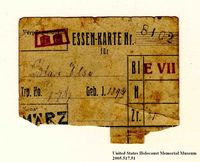
Theresienstadt ghetto-labor camp food coupon issued to an Austrian Jewish prisoner
Object
Ration coupon used by Elsa Blau when she and her family were imprisoned in the Theresienstadt ghetto-labor camp from 1942-1945. All currency was confiscated upon entry and replaced with scrip and ration coupons that could be exchanged only in the camp. Elsa, her husband, Adolph, two children, and her mother were deported from Vienna, Austria, in 1942. They lived in the camp until the International Red Cross took over administration of the camp from the Germans on May 2, 1945. The family then was transferred to the Deggendorf displaced persons camp in Germany where they lived until their immigration to the United States in 1948.
![Theresienstadt ghetto-labor camp Kaffeehaus [Coffee house] coupon issued to an Austrian Jewish prisoner Theresienstadt ghetto-labor camp Kaffeehaus [Coffee house] coupon issued to an Austrian Jewish prisoner](https://www.ushmm.org/media/emu/get?irn=517874&mm_irn=501347&file=secondary)
Theresienstadt ghetto-labor camp Kaffeehaus [Coffee house] coupon issued to an Austrian Jewish prisoner
Object
Ration coupon used by Adolph Blau and his family when they were imprisoned in the Theresienstadt ghetto-labor camp. All currency was confiscated upon entry and replaced with scrip and ration coupons that could be exchanged only in the camp. Adolph, his wife, two children, and mother-in-law were deported from Vienna, Austria, in 1942. They lived in the camp until the International Red Cross took over administration of the camp from the Germans on May 2, 1945. The family then was transferred to the Deggendorf displaced persons camp in Germany where they lived until their immigration to the United States in 1948.
![Theresienstadt ghetto-labor camp Kaffeehaus [Coffee house] coupon issued to an Austrian Jewish prisoner Theresienstadt ghetto-labor camp Kaffeehaus [Coffee house] coupon issued to an Austrian Jewish prisoner](https://www.ushmm.org/media/emu/get?irn=517877&mm_irn=501350&file=secondary)
Theresienstadt ghetto-labor camp Kaffeehaus [Coffee house] coupon issued to an Austrian Jewish prisoner
Object
Ration coupon used by Elsa Blau when she and her family were imprisoned in the Theresienstadt ghetto-labor camp from 1942-1945. All currency was confiscated upon entry and replaced with scrip and ration coupons that could be exchanged only in the camp. Elsa, her husband, Adolph, two children, and her mother were deported from Vienna, Austria, in 1942. They lived in the camp until the International Red Cross took over administration of the camp from the Germans on May 2, 1945. The family then was transferred to the Deggendorf displaced persons camp in Germany where they lived until their immigration to the United States in 1948.
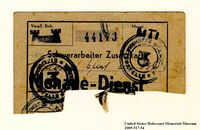
Theresienstadt ghetto-labor camp food coupon issued to an Austrian Jewish prisoner
Object
Ration coupon used by Adolph Blau and his family when they were imprisoned in the Theresienstadt ghetto-labor camp. All currency was confiscated upon entry and replaced with scrip and ration coupons that could be exchanged only in the camp. Adolph, his wife, two children, and mother-in-law were deported from Vienna, Austria, in 1942. They lived in the camp until the International Red Cross took over administration of the camp from the Germans on May 2, 1945. The family then was transferred to the Deggendorf displaced persons camp in Germany where they lived until their immigration to the United States in 1948.
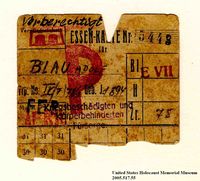
Theresienstadt ghetto-labor camp food coupon issued to an Austrian Jewish prisoner
Object
Ration coupon used by Adolph Blau and his family when they were imprisoned in the Theresienstadt ghetto-labor camp. All currency was confiscated upon entry and replaced with scrip and ration coupons that could be exchanged only in the camp. Adolph, his wife, two children, and mother-in-law were deported from Vienna, Austria, in 1942. They lived in the camp until the International Red Cross took over administration of the camp from the Germans on May 2, 1945. The family then was transferred to the Deggendorf displaced persons camp in Germany where they lived until their immigration to the United States in 1948.
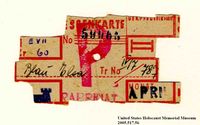
Theresienstadt ghetto-labor camp food coupon issued to an Austrian Jewish prisoner
Object
Ration coupon used by Adolph Blau and his family when they were imprisoned in the Theresienstadt ghetto-labor camp. All currency was confiscated upon entry and replaced with scrip and ration coupons that could be exchanged only in the camp. Adolph, his wife, two children, and mother-in-law were deported from Vienna, Austria, in 1942. They lived in the camp until the International Red Cross took over administration of the camp from the Germans on May 2, 1945. The family then was transferred to the Deggendorf displaced persons camp in Germany where they lived until their immigration to the United States in 1948.

Theresienstadt ghetto-labor camp food coupon issued to an Austrian Jewish prisoner
Object
Ration coupon used by Adolph Blau and his family when they were imprisoned in the Theresienstadt ghetto-labor camp. All currency was confiscated upon entry and replaced with scrip and ration coupons that could be exchanged only in the camp. Adolph, his wife, two children, and mother-in-law were deported from Vienna, Austria, in 1942. They lived in the camp until the International Red Cross took over administration of the camp from the Germans on May 2, 1945. The family then was transferred to the Deggendorf displaced persons camp in Germany where they lived until their immigration to the United States in 1948.
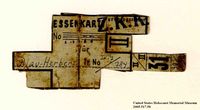
Theresienstadt ghetto-labor camp food coupon issued to an Austrian Jewish prisoner
Object
Ration coupon used by Adolph Blau and his family when they were imprisoned in the Theresienstadt ghetto-labor camp. All currency was confiscated upon entry and replaced with scrip and ration coupons that could be exchanged only in the camp. Adolph, his wife, two children, and mother-in-law were deported from Vienna, Austria, in 1942. They lived in the camp until the International Red Cross took over administration of the camp from the Germans on May 2, 1945. The family then was transferred to the Deggendorf displaced persons camp in Germany where they lived until their immigration to the United States in 1948.
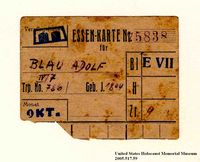
Theresienstadt ghetto-labor camp food ration coupon issued to an Austrian Jewish prisoner
Object
Ration coupon used by Adolph Blau and his family when they were imprisoned in the Theresienstadt ghetto-labor camp. All currency was confiscated upon entry and replaced with scrip and ration coupons that could be exchanged only in the camp. Adolph, his wife, two children, and mother-in-law were deported from Vienna, Austria, in 1942. They lived in the camp until the International Red Cross took over administration of the camp from the Germans on May 2, 1945. The family then was transferred to the Deggendorf displaced persons camp in Germany where they lived until their immigration to the United States in 1948.
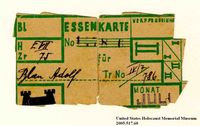
Two Theresienstadt ghetto-labor camp food ration coupons issued to an Austrian Jewish prisoner
Object
Two ration coupon used by Adolph Blau and his family when they were imprisoned in the Theresienstadt ghetto-labor camp. All currency was confiscated upon entry and replaced with scrip and ration coupons that could be exchanged only in the camp. Adolph, his wife, two children, and mother-in-law were deported from Vienna, Austria, in 1942. They lived in the camp until the International Red Cross took over administration of the camp from the Germans on May 2, 1945. The family then was transferred to the Deggendorf displaced persons camp in Germany where they lived until their immigration to the United States in 1948.
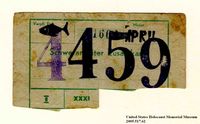
Theresienstadt ghetto-labor camp ration coupon issued to an Austrian Jewish prisoner
Object
Ration coupon used by Adolph Blau and his family when they were imprisoned in the Theresienstadt ghetto-labor camp. All currency was confiscated upon entry and replaced with scrip and ration coupons that could be exchanged only in the camp. Adolph, his wife, two children, and mother-in-law were deported from Vienna, Austria, in 1942. They lived in the camp until the International Red Cross took over administration of the camp from the Germans on May 2, 1945. The family then was transferred to the Deggendorf displaced persons camp in Germany where they lived until their immigration to the United States in 1948.
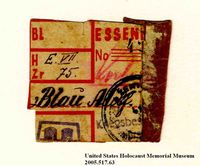
Theresienstadt ghetto-labor camp food ration coupon issued to an Austrian Jewish prisoner
Object
Ration coupon used by Adolph Blau and his family when they were imprisoned in the Theresienstadt ghetto-labor camp. All currency was confiscated upon entry and replaced with scrip and ration coupons that could be exchanged only in the camp. Adolph, his wife, two children, and mother-in-law were deported from Vienna, Austria, in 1942. They lived in the camp until the International Red Cross took over administration of the camp from the Germans on May 2, 1945. The family then was transferred to the Deggendorf displaced persons camp in Germany where they lived until their immigration to the United States in 1948.
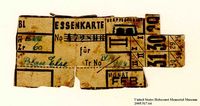
Theresienstadt ghetto-labor camp food ration coupon issued to an Austrian Jewish prisoner
Object
Ration coupon used by Adolph Blau and his family when they were imprisoned in the Theresienstadt ghetto-labor camp. All currency was confiscated upon entry and replaced with scrip and ration coupons that could be exchanged only in the camp. Adolph, his wife, two children, and mother-in-law were deported from Vienna, Austria, in 1942. They lived in the camp until the International Red Cross took over administration of the camp from the Germans on May 2, 1945. The family then was transferred to the Deggendorf displaced persons camp in Germany where they lived until their immigration to the United States in 1948.
Portrait of a young female inmate created in Theresienstadt ghetto
Object
Portrait drawing of 19-year old Trudy (Gertrude) Blau done in the Theresienstadt ghetto on January 13, 1944, by Alfred Bergel. In 1942, Trudy and her family were deported by the Germans from Vienna, Austria, to Theresienstadt in Czechoslovakia. In 1944, Trudy volunteered to go to Auschwitz with friends selected for transport. From there, she was sent to Kurzbach labor camp, where she worked digging ditches and contracted typhoid fever. In January 1945, the Germans evacuated the camp because of advancing Soviet forces. Trudy was liberated during the forced march in Liegnitz, Germany. She found her family in Theresienstadt in spring 1945. The Red Cross took over the Terezin camp on May 2. The family was transferred to Deggendorf displaced persons camp in Germany where they lived until their emigration to the United States in 1948. Bergel, age 42, had been deported to Auschwitz-Birkenau extermination camp and murdered in October 1944.
Andachtsbuch : Deutsche gebete zur häuslichen und öffentlichen andacht für israelitische mädchen und jungfrauen [Book]
Object
Jewish devotional book used in Theresienstadt ghetto-labor camp by the Blau family, Adolph, his wife, two children, and mother-in-law who were deported from Vienna, Austria, in 1942. They lived in the camp until the International Red Cross took over administration of the camp from the Germans on May 2, 1945. The family then was transferred to the Deggendorf displaced persons camp in Germany where they lived until their immigration to the United States in 1948.
Book
Object
Book of poetry about Theresienstadt ghetto-labor camp owned by the Blau family, Adolph, his wife, two children, and mother-in-law who were deported from Vienna, Austria, in 1942. They lived in the camp until the International Red Cross took over administration of the camp from the Germans on May 2, 1945. The family then was transferred to the Deggendorf displaced persons camp in Germany where they lived until their immigration to the United States in 1948.
Book
Object
Book of poetry about Theresienstadt ghetto-labor camp owned by the Blau family, Adolph, his wife, two children, and mother-in-law who were deported from Vienna, Austria, in 1942. They lived in the camp until the International Red Cross took over administration of the camp from the Germans on May 2, 1945. The family then was transferred to the Deggendorf displaced persons camp in Germany where they lived until their immigration to the United States in 1948.



